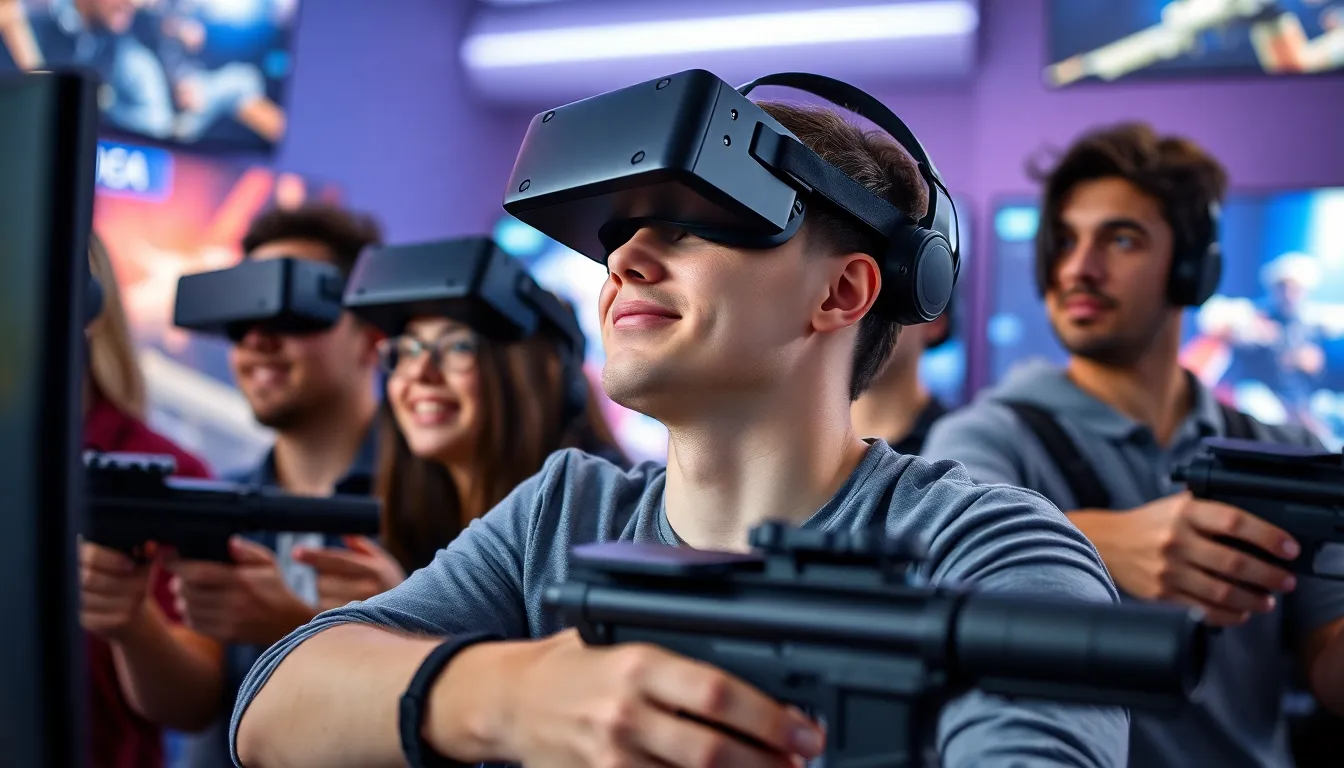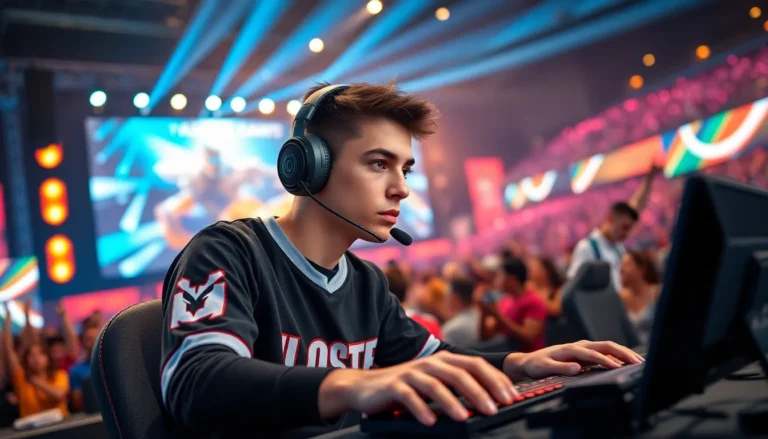Imagine stepping into a world where every heartbeat echoes in your ears and every pixel bursts with life. That’s the magic of FPS virtual reality, where gamers don’t just play—they live the action. It’s like being the star of your own blockbuster movie, but without the pesky paparazzi following you around.
In this immersive realm, players can dodge bullets, strategize with teammates, and even unleash their inner action hero—all from the comfort of their living rooms. With technology advancing faster than a speeding bullet, FPS VR is transforming gaming into an adrenaline-pumping experience that’s hard to resist. So grab your headset and prepare for a wild ride that’ll have you wondering if you’ve accidentally stepped into a sci-fi flick.
Table of Contents
ToggleOverview of FPS Virtual Reality
FPS virtual reality gaming creates a fully immersive environment where players assume the perspective of their character. Engaging gameplay mechanics allow individuals to navigate through various scenarios, whether they’re in combat zones or futuristic landscapes. Technology advancements are at the forefront of this genre, significantly enhancing graphics and responsiveness.
The importance of head tracking cannot be overstated in FPS VR. It enables players to look around, aim, and interact with the game world naturally. Controllers equipped with motion sensors provide intuitive control, allowing for dynamic shooting and movement. This setup encourages a more authentic experience, making players feel as if they’re part of the action.
Popular titles in FPS VR, such as “Half-Life: Alyx” and “Boneworks,” exemplify high-quality experiences. These games showcase not only stunning visuals but also complex physics interactions. Environments are meticulously designed to encourage exploration and tactical play, keeping players engaged for hours.
Multiplayer modes offer social interactions that enhance the overall experience. Players can team up with friends or face opponents in thrilling matches, reinforcing the competitive aspect of FPS gaming. Communication tools, such as in-game voice chat, foster strategic planning and teamwork, elevating the stakes.
The community surrounding FPS VR continues to grow, with game developers updating content and adding features. Player feedback is crucial in shaping future gaming experiences, ensuring the genre evolves to meet expectations. As FPS virtual reality becomes more accessible, its popularity among gamers is set to expand further.
Key Features of FPS Virtual Reality

FPS virtual reality offers captivating elements that enhance the player’s experience. Each feature contributes uniquely to the overall immersion.
Immersive Gameplay
Immersive gameplay defines FPS virtual reality, allowing players to engage directly in the action. Players experience a heightened sense of presence, making them feel as if they’re physically in the game. Realistic sound effects and responsive controls deepen this immersion, enhancing reactions during gameplay. Titles like “Echo Arena” exemplify this feature, delivering fast-paced, adrenaline-pumping experiences. Multiplayer modes amplify immersion, letting players strategize in real time. Collaborative tactics become essential for success in high-pressure scenarios.
Realistic Graphics
Realistic graphics dramatically enhance the visual experience in FPS virtual reality. High-resolution textures and detailed environments create lifelike settings. Players become absorbed when they encounter richly rendered landscapes and accurate character models. Games such as “Boneworks” push the boundaries of visual fidelity, offering stunning visual effects. Advanced rendering techniques further elevate realism, allowing for shadows and lighting that mimic real life. These visual elements foster a deeper emotional connection, making every moment feel significant.
Interactive Environments
Interactive environments elevate gameplay by providing unique experiences in FPS virtual reality. Players can manipulate objects, navigate obstacles, and engage with their surroundings creatively. Environments react dynamically to player actions, enhancing realism and engagement. For instance, in “Half-Life: Alyx,” physic-based mechanics influence interactions, promoting exploration. These features encourage players to experiment and discover hidden secrets within the game world. Overall, interactions within the environment offer varied gameplay possibilities, maintaining excitement in each session.
Popular FPS Virtual Reality Games
FPS virtual reality games deliver thrilling experiences that captivate players. They offer intense gameplay and high-quality visuals, perfect for enthusiasts seeking action-packed adventure.
Half-Life: Alyx
“Half-Life: Alyx” sets a new standard in VR gaming. Players navigate a richly detailed world while solving puzzles and engaging in combat. The game’s narrative draws players into a gripping storyline, emphasizing character development and immersion. Realistic physics enhance interactions, allowing players to manipulate items creatively. This depth encourages exploration and strategic gameplay, while multiplayer features promote social interaction within the community.
Boneworks
“Boneworks” showcases advanced physics mechanics that revolutionize virtual interactions. Players experience unparalleled freedom to experiment with weapons and environmental elements. Physics-driven gameplay provides unique challenges, making every encounter unpredictable and exhilarating. Its robust multiplayer capabilities enable players to connect and strategize together. The diverse environments keep experiences fresh, driving players to uncover all the game’s secrets.
Echo Arena
“Echo Arena” emphasizes fast-paced competition with a unique sports twist. This game merges FPS mechanics with team-based strategies, fostering intense multiplayer matches. Players can take part in thrilling zero-gravity battles, where teamwork and skill shine. The immersive environments engage players, enabling them to develop tactics on the fly. Continuous updates and community feedback ensure the game evolves, enhancing its gameplay experience.
Benefits of FPS Virtual Reality
FPS virtual reality gaming offers several benefits that enhance the overall player experience. These advantages include enhanced engagement and skill development, which together create a unique environment for gamers.
Enhanced Engagement
Immerse players in their games like never before. Virtual reality’s capabilities create lifelike scenarios that captivate attention. Players experience intense emotions while navigating through dynamic environments. They feel the rush of adrenaline as they dodge bullets and execute tactical maneuvers. Multiplayer features strengthen connections by promoting teamwork and communication. Communities develop around these games, fostering social interactions that keep players invested. By integrating meaningful narratives and stunning graphics, FPS VR games maintain a high level of player immersion throughout their gameplay.
Skill Development
Players sharpen various skills through their FPS VR experiences. They quickly improve hand-eye coordination as they navigate fast-paced scenarios. Strategy formulation becomes second nature when players collaborate and communicate with teammates. Critical thinking develops as players assess their environments and make split-second decisions. Adapting to different gameplay styles enhances versatility in problem-solving. Gamers benefit from real-time feedback, helping them refine techniques and strategies. This immersive environment encourages ongoing learning, allowing players to continuously develop their skills and enhance their performance.
Challenges in FPS Virtual Reality
FPS virtual reality experiences aren’t without their challenges. Two prominent issues often faced by players involve motion sickness and hardware limitations.
Motion Sickness
Motion sickness frequently occurs in FPS VR. Discrepancies between visual movement and physical sensations can lead to discomfort, nausea, or dizziness. Many players report feelings of unease during fast-paced gameplay. Adjustments in settings, such as field of view and movement speed, often alleviate these symptoms. Developers actively work on integrating comfort options to enhance player experience. Techniques like teleportation mechanics provide alternatives to traditional movement, helping reduce the likelihood of motion sickness.
Hardware Limitations
Hardware limitations significantly impact FPS VR performance. High-quality graphics and real-time processing demand powerful equipment. Many players may find their devices inadequate for optimal performance, leading to frame rate drops or latency issues. Graphics cards, RAM, and processing speed play crucial roles in rendering immersive environments. Upgrading hardware can be costly or inaccessible for some users. Moreover, the need for external sensors or extensive space further complicates setup, limiting accessibility for a broader audience. Developers seek to optimize experiences while considering varying hardware capabilities.
FPS virtual reality gaming stands at the forefront of immersive entertainment. As players engage in heart-pounding action and strategic gameplay, they experience a new level of excitement that traditional gaming can’t match. The blend of advanced technology and community interaction creates a vibrant ecosystem where gamers can thrive.
While challenges like motion sickness and hardware requirements exist, ongoing innovations promise to enhance accessibility and comfort. The future of FPS VR looks bright as developers continue to refine experiences and push the boundaries of what’s possible. With its captivating gameplay and social elements, FPS virtual reality is set to redefine how players connect with games and each other.



